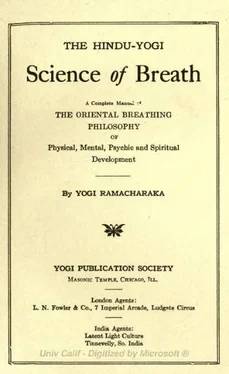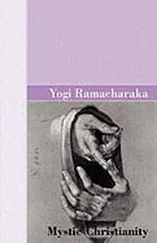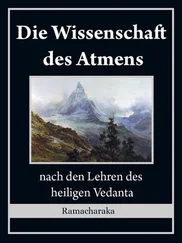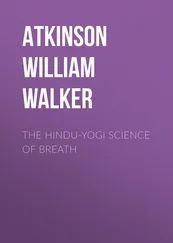EXERCISE V.
(1) Stand erect with your palms against the wall.
(2) Inhale Complete Breath and retain.
(3) Lower the chest to the wall, resting your weight on your hands.
(4) Then raise yourself back with the arm muscles alone, keeping the body stiff.
(5) Exhale vigorously through the mouth.
(6) Practice Cleansing Breath.
EXERCISE VI.
(1) Stand erect with arms "akimbo," that is, with hands resting around the waist and elbows standing out.
(2) Inhale Complete Breath and retain.
(3) Keep legs and hips stiff and bend well forward, as If bowing, at the same time exhaling slowly.
(4) Return to first position and take another Complete Breath.
(5) Then bend backward, exhaling slowly.
(6) Return to first position and take a Complete Breath.
(7) Then bend sideways, exhaling slowly. (Vary by bending to right and then to left.)
(8) Practice Cleansing Breath.
EXERCISE VII.
(1) Stand erect, or sit erect, with straight spinal column.
(2) Inhale a Complete Breath, but instead of inhaling in a continuous steady stream, take a series of short, quick "sniffs," as if you were smelling aromatic salts or ammonia and did not wish to get too strong a "whiff." Do not exhale any of these little breaths, but add one to the other until the entire lung space Is filled.
(3) Retain for a few seconds.
(4) Exhale through the nostrils in a long, restful, sighing breath.
(5) Practice Cleansing Breath.
CHAPTER XIII. VIBRATION AND YOGI RHYTHMIC BREATHING
All is in vibration. From the tiniest atom to the greatest sun, everything is in a state of vibration. There is nothing in absolute rest in nature. A single atom deprived of vibration would wreck the universe. In incessant vibration the universal work is performed. Matter is being constantly played upon by energy and countless forms and numberless varieties result, and yet even the forms and varieties are not permanent. They begin to change the moment they are created, and from them are born innumerable forms, which in turn change and give rise to newer forms, and so on and on, in infinite succession. Nothing is permanent in the world of forms, and yet the great Reality is unchangeable. Forms are but appearances-they come, they go, but the Reality is eternal and unchangeable.
The atoms of the human body are in constant vibration. Unceasing changes are occurring. In a few months there is almost a complete change in the matter composing the body, and scarcely a single atom now composing your body will be found in It a few months hence. Vibration, constant vibration. Change, constant change.
In all vibration is to be found a certain rhythm. Rhythm pervades the universe. The swing of the planets around the sun; the rise and fall of the sea; the beating of the heart; the ebb and flow of the tide; all follow rhythmics laws. The rays of the sun reach us; the rain descends upon us, in obedience to the same law. All growth is but an exhibition of this law. All motion is a manifestation of the law of rhythm.
Our bodies are as much subject to rhythmic laws as is the planet in its revolution around the sun. Much of the esoteric side of the Yogi Science of Breath is based upon this known principle of nature. By falling in with the rhythm of the body, the Yogi manages to absorb a great amount of Prana, which he disposes of to bring about results desired by him. We will speak of this at greater length later on.
The body which you occupy is like a small inlet running in to the land from the sea. Although apparently subject only to its own laws, it is really subject to the ebb and flow of the tides of the ocean. The great sea of life is swelling and receding, rising and falling, and we are responding to its vibrations and rhythm. In a normal condition we receive the vibration and rhythm of the great ocean of life, and respond to it, but at times the mouth of the inlet seems choked up with debris, and we fail to receive the impulse from Mother Ocean, and inharmony manifests within us.
You have heard how a note on a violin, if sounded repeatedly and in rhythm, will start into motion vibrations which will in time destroy a bridge. The same result is true when a regiment of soldiers crosses a bridge, the order being always given to "break step" on such an occasion, lest the vibration bring down both bridge and regiment. These manifestations of the effect of rhythmic motion will give you an idea of the effect on the body of rhythmic breathing. The whole system catches the vibration and becomes in harmony with the will, which causes the rhythmic motion of the lungs, and while in such complete harmony will respond readily to orders from the will. With the body thus attuned, the Yogi finds no difficulty in increasing the circulation in any part of the body by an order from the will, and in the same way he can direct an increased current of nerve force to any part or organ, strengthening and stimulating it.
In the same way the Yogi by rhythmic breathing "catches the swing," as it were, and is able to absorb and control a greatly increased amount of prana, which is then at the disposal of his will. He can and does use it as a vehicle for sending forth thoughts to others and for attracting to him all those whose thoughts are keyed in the same vibration. The phenomena of telepathy, thought transference, mental healing, mesmerism, etc., which subjects are creating such an interest in the Western world at the present time, but which have been known to the Yogis for centuries, can be greatly increased and augmented If the person sending forth the thoughts will do so after rhythmic breathing. Rhythmic breathing will increase the value of mental healing, magnetic healing, etc., several hundred per cent.
In rhythmic breathing the main thing to be acquired is the mental idea of rhythm. To those who know anything of music, the idea of measured counting is familiar. To others, the rhythmic step of the soldier: "Left, right; left, right; left, right; one, two, three, four; one, two, three, four," will convey the idea.
The Yogi bases his rhythmic time upon a unit corresponding with the beat of his heart. The heart beat varies in different persons, but the heart beat unit of each person is the proper rhythmic standard for that particular individual in his rhythmic breathing. Ascertain your normal heart beat by placing your fingers over your pulse, and then count: "1, 2, 3, 4, 5, 6; 1, 2, 3, 4, 5, 6," etc., until the rhythm becomes firmly fixed in your mind. A little practice will fix the rhythm, so that you will be able to easily reproduce it. The beginner usually inhales in about six pulse units, but he will be able to greatly increase this by practice.
The Yogi rule for rhythmic breathing is that the units of inhalation and exhalation should be the same, while the units for retention and between breaths should be one-half the number of those of inhalation and exhalation.
The following exercise in Rhythmic Breathing should be thoroughly mastered, as it forms the basis of numerous other exercises, to which reference will be made later.
(1) Sit erect, in an easy posture, being sure to hold the chest, neck and head as nearly in a straight line as possible, with shoulders slightly thrown back and hands resting easily on the lap. In this position the weight of the body is largely supported by the ribs and the position may be easily maintained. The Yogi has found that one cannot get the best effect of rhythmic breathing with the chest drawn in and the abdomen protruding.
(2) Inhale slowly a Complete Breath, counting six pulse units.
(3) Retain, counting three pulse units.
(4) Exhale slowly through the nostrils, counting six pulse units.
(5) Count three pulse beats between breaths.
Читать дальше












